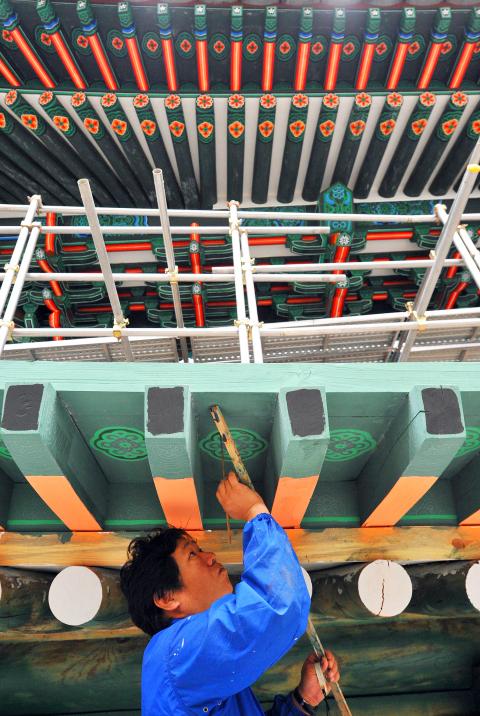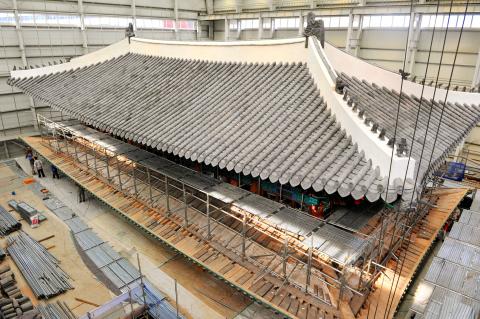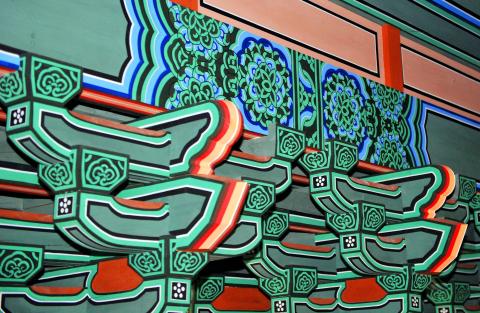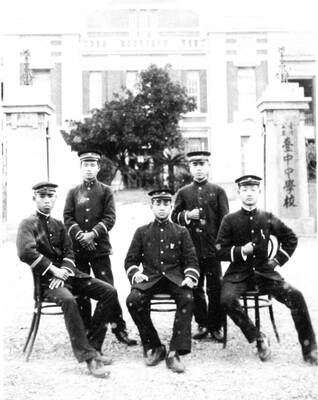Five years ago, as he watched TV images of South Korea’s foremost historical treasure being engulfed in flames lit by a lone arsonist, Hong Chang-Won remembers having to turn his head away.
“It was too heartbreaking to see such beautiful architecture being destroyed like that,” said Hong, a registered master craftsman who specializes in traditional Korean ornamental painting.
Seoul’s 600-year-old Namdaemun (South Gate), listed as “National Treasure Number One” and a source of immense cultural pride, was burned pretty much to the ground on February 10, 2008.

Photo: AFP
The largely wooden structure that had managed to survive the devastation of the 1950-53 Korean War was reduced to ashes by a disgruntled 69-year-old man with some paint thinner and a cigarette lighter.
Nearly five years later, following one of the longest, most expensive restoration projects ever undertaken in South Korea that involved scores of highly-skilled artisans like Hong, Namdaemun is ready to return.
The restored landmark is set to be unveiled in late December.

Photo: AFP
From the outset of the US$22.7 million project, the Cultural Heritage Administration had decided that the reconstruction work should be carried out as faithfully to the original as possible.
“It has been extremely difficult, but given that it’s Korea’s landmark, we put traditional methods and materials as our highest priority,” said the head of the administration’s restoration team, Cho Kyu-Hyung.
“The building holds not only a historical significance, but also a great symbolic meaning for all Koreans,” Cho told AFP during a preview tour.

Photo: AFP
Building from the past
Historians and master craftsmen using traditional construction techniques were invited to review documents dating back centuries, as well as a blueprint drawn up in 1963 when the government dismantled the gate for repair work.
“The only modern ‘tools’ that we used were trucks to deliver the stone and timber. Otherwise everything was done using original technologies,” Cho said.
Molten steel was poured into special moulds to fashion traditional-style nails, while all 22,000 roof tiles were handmade.
Hundreds of pieces of pine timber had all been cut and allowed to dry out naturally — a process that takes several years — and the stonework was cut and crafted with traditional tools.
Decorative paints, however, had to be imported from Japan, since the art of making them in the traditional fashion, without chemicals, had been lost among Korean specialists.
Six master craftsmen specializing in stonecraft, woodcraft, roof tiles and ornamental painting were invited onto the project, said Cho, with each craftsman assisted by as many as 40 licensed apprentices.
As the expert in charge of the painting, Hong’s team was the last to work on the project and he watched carefully as the apprentices followed his outlines of lotus flowers and leaf patterns drawn on the giant timbers.
“We tried hard to restore the colors and styles of the time when it was actually built,” Hong said.
“At first glance, the newer Namdaemun might look less colorful and rather toned down, but it will look much more serene and graceful,” he added.
The dominant colors were of light blue and dark green, with more vivid tones of orange and red used only as highlights.
The patterns were copied from temples built around the same time, as well as pictures taken from the early 1900s.
“And since some pillars remained intact even after the fire, we also took them into account,” Hong said.
Protecting for the future
The pagoda-style, two-story gate located in the center of downtown Seoul was first constructed in 1398, then rebuilt in 1447 and renovated several times after that.
The structure that burned down in 2008 had still contained some 600-year-old timber. The fire took out the entire roof, most of the upper floor and some of the lower floor.
Proposals to give the restored version a fire-resistant coat was rejected, Cho said, because it would have caused some discoloration of the paintwork.
“We did research and tests and came to conclusion that the best solution was to take every possible precautionary measure, such as installing thermal sensors around the building,” Cho said.
The destruction of Namdaemun sent shock waves through the country, with sorrowful Seoul residents swarming around the charred ruin, laying flowers and writing grieving messages.
The arsonist, Chae Jong-Gi, was eventually jailed for 10 years.
A court ruled he had “inflicted unbearable agony on the people and damaged national pride,” noting that the gate had been considered “the treasure among all treasures which had survived all kinds of historic disasters.”

In the March 9 edition of the Taipei Times a piece by Ninon Godefroy ran with the headine “The quiet, gentle rhythm of Taiwan.” It started with the line “Taiwan is a small, humble place. There is no Eiffel Tower, no pyramids — no singular attraction that draws the world’s attention.” I laughed out loud at that. This was out of no disrespect for the author or the piece, which made some interesting analogies and good points about how both Din Tai Fung’s and Taiwan Semiconductor Manufacturing Co’s (TSMC, 台積電) meticulous attention to detail and quality are not quite up to

April 28 to May 4 During the Japanese colonial era, a city’s “first” high school typically served Japanese students, while Taiwanese attended the “second” high school. Only in Taichung was this reversed. That’s because when Taichung First High School opened its doors on May 1, 1915 to serve Taiwanese students who were previously barred from secondary education, it was the only high school in town. Former principal Hideo Azukisawa threatened to quit when the government in 1922 attempted to transfer the “first” designation to a new local high school for Japanese students, leading to this unusual situation. Prior to the Taichung First

Chinese Nationalist Party (KMT) Chairman Eric Chu (朱立倫) hatched a bold plan to charge forward and seize the initiative when he held a protest in front of the Taipei City Prosecutors’ Office. Though risky, because illegal, its success would help tackle at least six problems facing both himself and the KMT. What he did not see coming was Taipei Mayor Chiang Wan-an (將萬安) tripping him up out of the gate. In spite of Chu being the most consequential and successful KMT chairman since the early 2010s — arguably saving the party from financial ruin and restoring its electoral viability —

The Ministry of Education last month proposed a nationwide ban on mobile devices in schools, aiming to curb concerns over student phone addiction. Under the revised regulation, which will take effect in August, teachers and schools will be required to collect mobile devices — including phones, laptops and wearables devices — for safekeeping during school hours, unless they are being used for educational purposes. For Chang Fong-ching (張鳳琴), the ban will have a positive impact. “It’s a good move,” says the professor in the department of